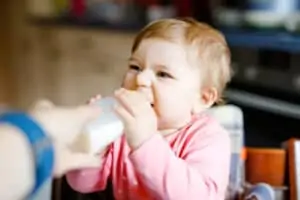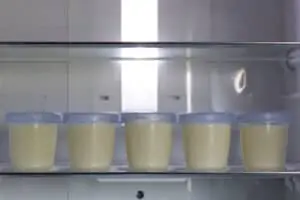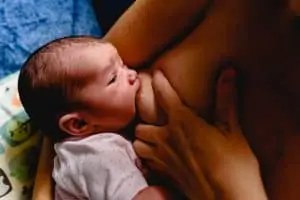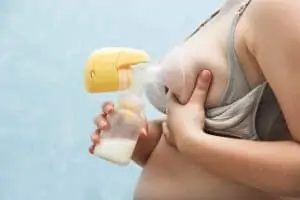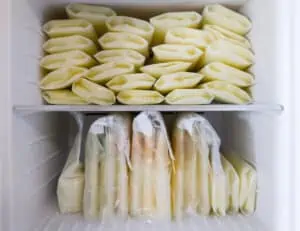The benefits of a breastmilk bath are something I’ve touched on recently. Due to getting a few more questions in my inbox about adding breast milk to a baby bath, I thought I’d cover it a little further.
After all, breast milk is a life force for our babies. It serves as their complete world of nutrition for the first 6 months and supplements their nutrition for the second 6 months as they are introduced to solids.
You’ll be mixing your solids with that milk too, and soon, you may wonder what to do with all that stashed milk as the baby starts weaning and heading toward the road of more solid foods.
As a side note, your baby will become less of a hot mess of an eater too, so try not to worry about that sloppy eating. Table manners come in due time.
In any event, I’ve got a breast milk bath recipe for you and the answers to all those additional questions about other uses for breast milk when you have either too much of a good thing or it’s not quite suitable for consumption.
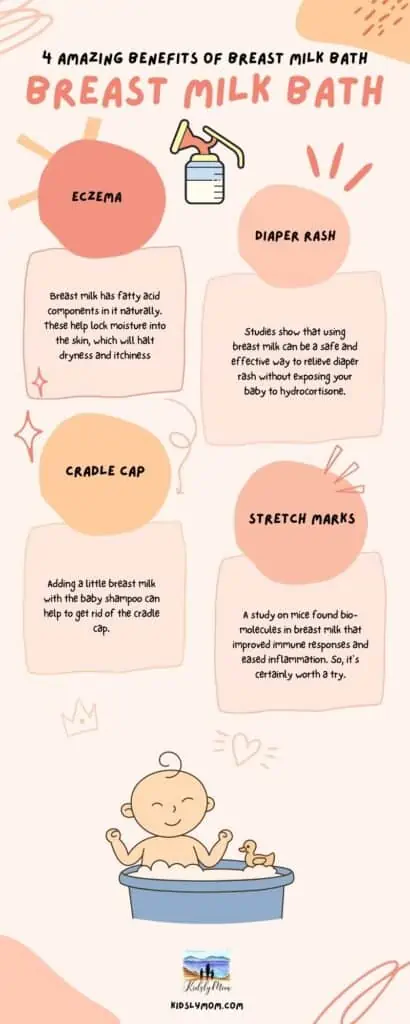
Is it ok to use expired breast milk for a milk bath?
In my last post, I advised about using expired breast milk. In a milk bath, though, as long as it doesn’t have the kind of smell that would bowl you over, it should be safe.

And it’s not like you’re filling a tub with just the expired breast milk. You’re adding it to water (more on that below). Breast milk has so many fantastic healing properties, so it’s little wonder why they’ve found a breastmilk bath for eczema, breastmilk for cradle cap, and breast milk for diaper rash to be so effective.
How do you make a breast milk bath?
It’s so easy!
All you’ll need to do is grab your breastmilk.
It can come from the freezer or your fridge. Or you can pump it fresh, but I recommend saving that fresh stuff for the baby to eat, especially when you’re trying to get rid of an old supply of milk that may not be suitable for drinking.
You’ll want about 2 bags worth of breast milk, FYI. Though you may need a bit more or less, depending on your tub’s size.
Now you’ll pour in the breastmilk and get the water cloudy. Then you’ll bathe the baby in the breast milk bath. You want to expose all her irritated skin parts to this water. She should be good for about 10 minutes (supervised with you staying within arm’s reach).
Then you can take your baby out of the bath and pat her dry. I’d also advise you quickly coat her skin in a non-irritating lotion. Hey, you can look in my last post and see how to make that breast milk lotion which would be a great way to keep the soothing going while sealing the moisture into her skin!
Is breast milk bath good for eczema?
Oh yes, it surely is. Breast milk has fatty acid components in it naturally. These help lock moisture into the skin, which will halt dryness and itchiness. Breast milk for eczema is so helpful, though it can also relieve diaper rash, cradle cap, and baby acne.
Yes, babies can get acne too! And you thought your teenage years were rough! Ha!
According to Medela, newborns can get acne right after being born or in the first few weeks. This is not something to worry over, though, because it’s normal and will clear up on its own. But you can reduce the irritation and help the baby look her best for all those baby photos by either giving her that breast milk bath or gently patting it onto the baby’s acne with a cotton ball soaked in the stuff.
Does breast milk help diaper rash?
Yes, breast milk for diaper rash is a great idea. Studies even show that it can be a safe and effective way to relieve it without exposing your baby to hydrocortisone. It’s certainly worth a try.

But do be advised it may not help all the time. Some say this isn’t quite as effective as using a dedicated diaper rash cream with cod liver oil and zinc oxide. Try them both and see. Either way, the diaper creams, and your breast milk are safe to apply to baby skin.
And as always, ask your doctor what they think about it if you have any additional concerns.
How to use breastmilk for cradle cap?
The cradle cap is easy to get rid of with breast milk. Some suggest adding a little breast milk with the baby shampoo, while others just use a diluted mixture of breast milk and water to saturate the scalp.
Either way, gently massage it with the tips of your fingers. Then you can rinse it away. After the baby is out of the bath, use a baby brush to brush the scalp gently. This will loosen the scaly parts of the skin.
Another way to do it is to apply breast milk to your baby’s scalp after washing her hair. However, be advised that if you do this without rinsing it away, your baby will smell like old milk.
Does breastmilk remove stretch marks?
And yes, mamas are wondering if breastmilk can help them with their skin concerns, and to that, I say go for it! You, too, can take that breast milk bath. And you may want to see if it helps with stretch marks.
Many women are curious if it could help them or even their babies with stretch marks. A study found bio-molecules in breast milk that improved immune responses and eased inflammation. However, this study was conducted in mice.
Still, the researchers were optimistic, but we can’t be sure since there’s nothing else to confirm this.
Breast milk has a bounty of amazing uses that go beyond providing hydration and nourishment to newborns, babies, and toddlers. I’ve covered that reasonably well, but if you’re curious about using it in breast milk baths and treating skin and scalp conditions, it can’t hurt you to try it out.
It’s not like it’s some caustic chemical. It’s a natural substance your body makes with enriching nutrients. While the older it is, the less of these things it will have, it may help you clear out space for storage of fresher milk your baby can ingest while using it up rather than throwing it all away.
Again, expired breast milk should be fine on the skin unless it has a horrid, spoiled smell. At that point, there’s really no saving it. But if it smells ok, give it a try to help soothe skin for you and your baby!
Leslie Berry lives with her husband and two young daughters in Los Altos, California, where she loves helping other moms get comfortable with motherhood and embracing the insanity with facts peppered with laughs.
She loves eating too much sushi, exercising, and jamming out on her Fender. Read more about Leslie here.


